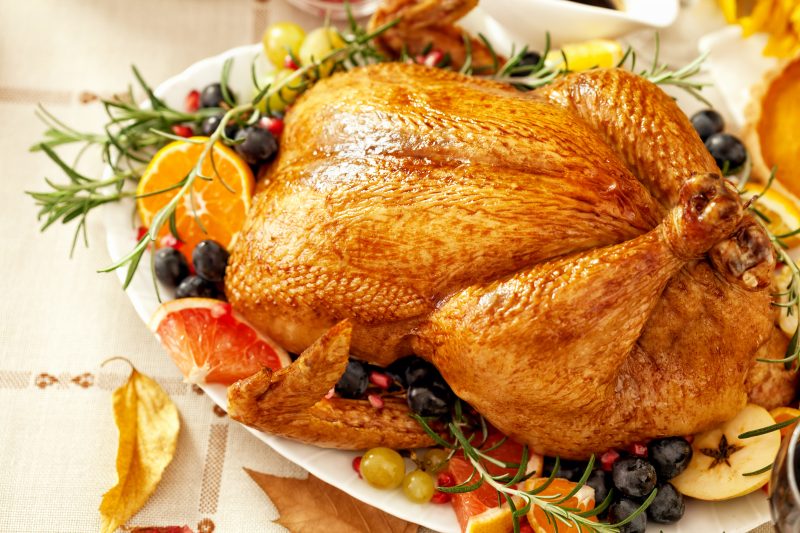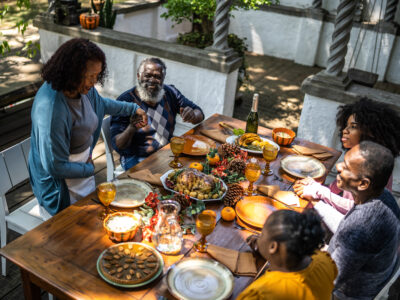Table of Contents[Hide][Show]
If you’ve ever hosted a Thanksgiving meal, you know there’s a lot of decisions to be made in the process: who to invite, where to put them all, what to make, how to accommodate everyone’s dietary needs. Often, we’re so busy and overwhelmed that we don’t put any thought into the environmental impact of our meal. Things like where to source your ingredients and how much ends up in the trash.
The US throws out around $293 million of turkey every Thanksgiving, which amounts to over 6 million turkeys! And the resources required to produce that much turkey is comparable to greenhouse gas emissions that equal 800,000 car trips from New York to San Francisco and enough water to supply New York City for 100 days. And that’s just the turkey waste! Consider all the other food items that get thrown out.

Tips for Reducing Food Waste at Thanksgiving
Now that we’ve got your attention, let’s review a few ways you can reduce food waste at this year’s Thanksgiving meal.
1. Budget Your Ingredients
Before shopping, check your kitchen for ingredients you already have. Try to buy only as much of an ingredient as you need. If you have to buy more, consider making a different recipe or plan future meals with the extras. Freeze extra ingredients when feasible. For example, extra fresh fruit can be frozen for smoothies.
2. Cook Less Food
Make half of each recipe, since people tend to fill their plates with a little of each dish. Don’t panic, there will still be PLENTY of food! Consider making fewer dishes total, and coordinate with guests to make sure they aren’t planning to bring dishes you’re already preparing.
3. Make Plans For Leftovers
There’s no doubt people love Thanksgiving leftovers, so make sure you have a plan for how you can utilize every last bit. You could:
- Ask guests to bring take-home containers.
- Freeze meal portions for another day.
- Make bone broth with turkey bones and scraps.
- Throw a leftovers potluck.

How to Select the Right Turkey
There are many considerations around the purchase of a turkey, and more and more claims and certifications that can make it hard to identify the best choice for your meal.
Basted, Self-Basting, Injected, or Enhanced
These turkeys are injected with various ingredients to add moisture and flavor, and are typically factory-farmed. These are the most affordable and easiest to prepare, but also the least environmentally-friendly, worst for animal welfare, and least healthy. These birds tend toward a spongy texture, and may be overly buttery or salty.
Natural
To be labeled natural, the USDA requires that the turkey not contain artificial ingredients or added color and is processed “in a manner that does not fundamentally alter the product.” These have an improved texture and flavor over the previous category.
Kosher
A Kosher turkey must be prepared under Rabbinical supervision, which means that it must be cared for ethically and slaughtered as humanely as possible. These birds come pre-brined in salt.
Free-Range
Turkeys with this label must be allowed access to the outdoors, but may still have spent most of their lives in a crowded indoor area. The more time outdoors, the leaner the meat. To be sure the turkey was truly a free-roaming bird, look for the word “pastured.”
Organic
Organic turkeys are fed organic grains and are not given antibiotics. They are often free-range birds (but not always, so be sure to check for additional labeling), and usually considered very flavorful.
Heritage
These earlier breeds of turkey are generally raised more humanely on truly free-range farms. They are thought of as having superior flavor. If you go this route, keep in mind that having less fat content means they have shorter cooking times.
Considering the statistics mentioned above, the most important thing to consider in your turkey purchase might just be the size. If you will be saving money by purchasing a small turkey and fewer ingredients, consider using the savings to go with higher-quality food that supports local farmers and better animal welfare standards or companies that are doing good in the world.
Consider Going Turkey-Free
In addition to the food and financial waste mentioned at the beginning of this post, did you know the Environment Working Group also rated turkey as the sixth highest in a report ranking the greenhouse gas emissions from common proteins?
What better way to reduce waste, keep more money in your pocket, and do something great for the environment and animals than to go turkey free this Thanksgiving? The appetizers, side dishes, and desserts are already so abundant that you could simply leave the turkey off your plate—or try a plant-based substitute if you’re so inclined—and still enjoy an amazing meal with family.
Final Thoughts
Don’t forget to be thankful for all the many options we have available to us for our holiday meal. What a privilege it is to have access to an abundance of nourishing foods!
You May Also Like…
References for this article:
- https://money.usnews.com/money/blogs/fresh-greens/2008/11/20/read-this-before-you-buy-your-thanksgiving-turkey
- https://www.fsis.usda.gov/wps/portal/fsis/topics/food-safety-education/get-answers/food-safety-fact-sheets/food-labeling/meat-and-poultry-labeling-terms/meat-and-poultry-labeling-terms
- https://www.marketwatch.com/story/this-is-how-much-food-americans-waste-at-thanksgiving-2016-11-22
- https://www.businessinsider.com/the-top-10-foods-with-the-biggest-environmental-footprint-2015-9





